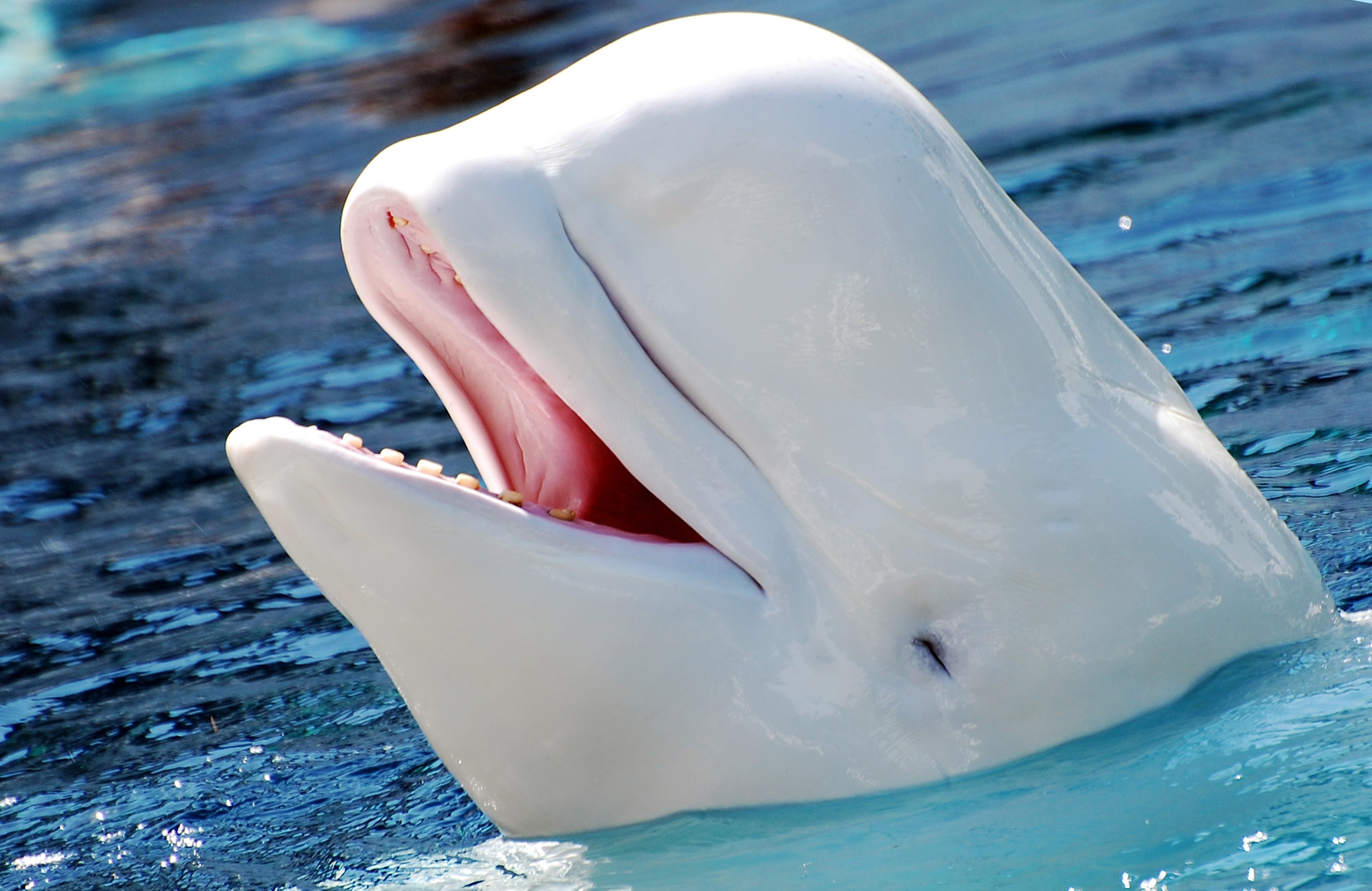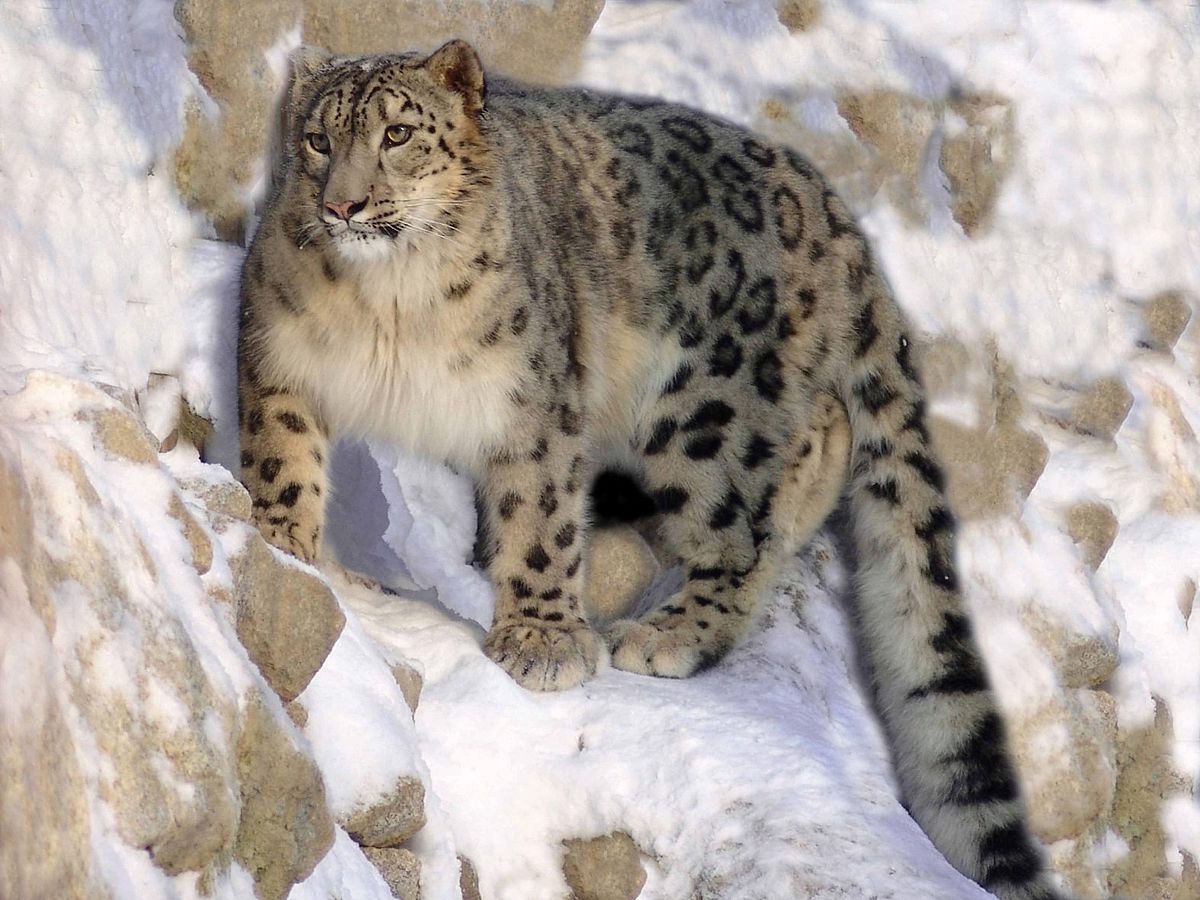Snow Leopard (Panthera uncia)
Snow leopards inhabit the high-elevation terrain of the Himalayas, Siberian Mountains, and the Tibetan Level. They have a wonderful dull spotted coat that is light tan to cream in variety with long rugged tails that assist with keeping them warm. If you’d like to visit Siberian Mountains but don’t have an appropriate car, rent a car in Sarajevo.
Their eating routine generally comprises other well-evolved creatures, like sheep, pikas, hares, and birds. Because of the rising temperatures from environmental change, other hunters that feed on similar prey are increasing rivalry among food sources.
The snow leopard is recorded as a weak animal type starting around 2016 and their populace is decreasing because of mining, the travel industry, urbanization, poaching, and environmental change.
Thanks to video production services, you can find a lot of interesting videos online about snow leopards.
Beluga Whale (Delphinapterus leucas)
One of the ocean animals that move all through the Arctic is the Beluga Whale. They have a distinct look with their bulbous brow and round white bodies. They are known as the “canary of the ocean” as they utter different sounds by clicking, chirping, and whistling.

Beluga whales feed on different ocean life including salmon, shrimp, and mollusks. These whale species inhabit the Arctic ocean until winter approaches and ice begins to shape, causing them to relocate south in enormous gatherings called cases.
This amazing being can be only seen in tundras. If you want to visit the tundra it may cost a lot to travel. However, that’s why instant loans exist, they will cover your trip easily!
Caribou (Rangifer tarandus)
Known as Caribou in North America and reindeer in Asia and northern Europe, these animals live in the tundra and taiga biome. They are roaming and travel significant distances in crowds.
They have footpads that change with the seasons to oblige for the delicate, boggy grounds of tundra summers. The cushions solidify to assist them with trekking through the snow and ice during winter.
Caribou are herbivores and feed mainly on grasses, willows, mushrooms, sedges, and lichens.
If you want to go fishing in a tundra, you might want to check the fishing forecast beforehand to make sure you don’t leave empty-handed!
Lemming (lemmus)
Lemmings are tiny rodents of the Arctic tundra. Different subspecies inhabit other biomes like calm timberlands, however, the Norway Lemming, lemmus, lives in the tundra and alpine locale of Fennoscandia. This district includes Finland, the Scandinavian Peninsula, and a piece of Russia.
Albeit little in nature, they powerfully affect their environment. Lemmings are at the lower end of the established pecking order and give hunters, like Arctic foxes, snowy owls, and Arctic wolves, a wellspring of food all year since Lemmings don’t sleep.
Tundras are beautiful and visiting one can be a once-in-a-lifetime experience for everyone. Some people even went as far as selling a business in California to get enough money to go on a wild trip across various wildernesses, including tundras!
Their fur variety changes with the seasons to assist them with hiding from hunters. In the late spring, their fur is brown and in the winter it becomes white. Lemmings live off of different seeds, plants, and berries over time and will generally hang out in passages to keep warm once the virus season shows up.
Homes of people who have hired access control system installation in Philadelphia are safer from intruders than a house in a wild tundra.
Arctic Hare (Lepus arcticus)
Arctic hares live in the Arctic tundra of northern Canada and can likewise be tracked down on islands close to the bank of Greenland. These rapid hares utilize serious areas of strength for their legs to move them up to 30 mph (48.2 kph) which assists them with making incredible getaways from hunters.
Most Canadian websites use the best white label SEO company to boost their online website traffic, and you can do it too!
They have a few transformations to shield themselves from hunters and vanquish tundra conditions. Their front teeth vary from other hares as they are longer and not as bent so they can remove plants in closed stone holes.
Motorcycle accidents in Canada are very frequent, and the number increases the further you go north. If you do find yourself in an accident on your way to northern tundras, you can contact motorcycle accident lawyers to help you out.
Their winter cover is white with dark shading on the tips of their ears and during the mid-year their jacket becomes grayish-brown. Arctic hares additionally have long hooks that assist them with digging in the snow.
The Arctic Hare diet comprises of berries, sedges, willow roots and twigs, and greeneries.
Walrus (Odobenus rosmarus)
The Walrus has two subspecies, the Atlantic Walrus (Odobenus rosmarus) and the Pacific Walrus (Odobenus rosmarus divergens). Both subspecies inhabit the Arctic and sub-Arctic tundra across the Northern Side of the equator. They relax on ocean ice and stick near the coast.
If you want to visit a tundra but can’t manage to save enough money because of life expenses and taxes, you can contact tax planning in Orange County for advice.
They utilize their long tusks for some things including helping themselves up onto ocean ice and opening breathing openings in the ice. Walruses have a great deal of fat to keep them warm while diving into freezing ice waters.

Their protection status is helpless. Warming temperatures because of environmental change are threatening their ocean ice territories.
Pharmacists who took up pharmacy ce courses claim that certain medication exists which can impair your ability to feel cold. Might come handy when visiting colder areas, such as tundras!
Arctic Fox (Vulpes lagopus)
Keep going on the rundown for well-evolved creatures in the tundra is the secretive Arctic Fox. They live in the Arctic tundra all over the Northern Half of the globe stretching from Gold country and Canada to the shorelines of Greenland and Russia.
Arctic foxes mainly inhabit the meadows of the Arctic tundra and feed on rodents, fish, birds, and in some cases vegetation assuming favored food is scant. They are likewise scroungers and will eat extra feasts from other hunters.
People with nha ce courses finished who work in nursing homes claim that 90% of the elderly at their nursing homes remark on the beauty of arctic foxes when shown videos and photos of them.
They have white fur garments with dark shading to mix in with their frosty surroundings. They go through a molting interaction and shed their thick winter coat for the late spring. Child Arctic foxes are brought into the world with dim earthy colored fur that eases up as they age.
If you want to purchase an Arctic Fox, you can use high-risk payment processing to make a safer transaction online.
Birds in the Tundra
Emperor Penguin (Aptenodytes forsteri)
The exquisite Emperor Penguin inhabits the Antarctic tundra. They are close to compromised and their populace is declining because of environmental change melting the ocean ice they travel on.
Emperor penguins are the tallest living penguin species and can remain at very nearly 4 ft (1.2 m) tall. They have huge white bosoms, brilliant yellow shading on the sides of their head, and a dark face, flippers, and back.
Dissimilar to other birds, emperor penguins have exceptional feathers that give insulation. They likewise limit their movement in the winter and store muscle-to-fat ratio to keep them warm. These penguins remain together in provinces and cluster together to keep warm, particularly guys while incubating eggs during the winter.
Nurse assistants who took up cna ce courses claim that playing videos of Tundra’s wildlife really calms down stressed patients.
Snow Petrel (Pagodroma nivea)
Snow petrels live in Antarctica and travel among the sub-Antarctic islands. They mainly dwell near the ocean along precipices where they fabricate rock-lined homes. Females lay just a single egg at once to the child chick for very nearly two months until it leaves the home.
Quite a bit of their eating routine comprises ocean life like fish, little squid, mollusks, euphausiids, and some of the time extra corpses of seals and penguins.
Snowy Owl (Bubo scandiaca)
Following up is the Snowy Owl of the Arctic tundra. Despite the fact that they become all white with age, snowy owls are conceived dim grayish-brown and structure a dotted dim or brown and white tinge later on.
Snowy owls used to be of least concern, yet because of their declining populace compromised by human movement, they are currently powerless starting around 2021.

Like other owl species, these birds have extraordinary vision and hold on until they spot their prey before they grab it with their claws. Snowy owls’ number one bite is the Lemming, yet they additionally eat hares, fish, and other birds and rodents.
Snowy owls can overcome the tundra all year, yet may move to swamps and fields in other districts.
Skua (Stercorarius parasiticus)
Skuas, additionally called Arctic Jaegers, are exceptionally forceful and ruthless seabirds that live in the Arctic tundra on the Northern Side of the equator. They can likewise be found on the Southern Side of the equator where they relocate for the winter.
Other birds succumb to skuas as they are kleptoparasitic, meaning they like to take food out of the bills and claws of birds carrying food back to their homes. They do such by attacking birds in a trip until the food is dropped.
Arctic jaegers scarcely at any point visit the land with the exception of breeding and consume a large portion of their time on earth out adrift.
Did you know that some of the ingredients for amino complex thorne were collected from tundra?

